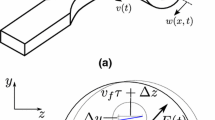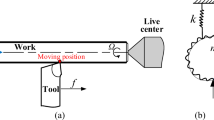Abstract
A universal frequency domain approach for studying the dynamics of metal cutting with a flexible workpiece and a compliant tool is derived. The method is used for the identification of the position-dependent stability lobes in turning. It enables a fast, accurate, and systematic stability analysis of turning processes in the parameter space, which is not restricted to simple dynamic models with only a specific number of modes in one spatial direction. In particular, a combination of experimental data for the tool tip dynamics with analytical or numerical data for the workpiece dynamics is possible, which is demonstrated by a concrete example. The effect of the mode interaction between tool and workpiece modes via the cutting process is illustrated. Counterintuitively, the possibility of a process destabilization for an increased workpiece stiffness was observed, which can be explained by the mode interaction. The presented methods and results can be efficiently used for optimizing machine tool development and process planning.
Similar content being viewed by others
References
Zhao MX, Balachandran B (2001) Dynamics and stability of milling process. Int J Solids Struct 38(10–13):2233– 2248
Khasawneh FA, Mann B, Insperger T, Stépán G (2009) Increased stability of low-speed turning through a distributed force and continuous delay model. J Comput Nonlin Dyn 4(4):041,003
Butcher E, Bobrenkov O, Bueler E, Nindujarla P (2009) Analysis of milling stability by the Chebyshev collocation method: Algorithm and optimal stable immersion levels. J Comp Nonlin Dyn 4(3):031,003
Otto A, Radons G (2013) Application of spindle speed variation for chatter suppression in turning. CIRP J Manuf Sci Technol 6(2):102–109
Yu SD, Shah V (2009) Theoretical and experimental studies of chatter in turning for uniform and stepped workpieces. J Vibr Acoustics 130(6):061,005
Gang L (2009) Study on deformation of titanium thin-walled part in milling process. J Mater Proc Technol 209(6):2788– 2793
Han X, Ouyang H, Wang M, Hassan N, Mao Y (2012) Self-excited vibration of workpieces in a turning process. Proc Inst Mech Eng C J Mech Eng Sci 226(8):1958–1970
Song Q, Ai X, Tang W (2011) Prediction of simultaneous dynamic stability limit of time-variable parameters system in thin-walled workpiece high-speed milling processes. Int J Adv Manuf Technol 55(9–12):883–889
Urbikain G, de Lacalle LL, Campa F, Fernandez A, Elias A (2012) Stability prediction in straight turning of a flexible workpiece by collocation method. Int J Mach Tools Manuf 54–55:73–81
Eksioglu C, Kilic Z, Altintas Y (2012) Discrete-time prediction of chatter stability, cutting forces, and surface location errors in flexible milling systems. J Manuf Sci Engin 134(6):061,006
Thevenot V, Arnaud L, Dessein G, Cazenave-Larroche G (2006) Integration of dynamic behaviour variations in the stability lobes method: 3d lobes construction and application to thin-walled structure milling. Int J Adv Manuf Technol 27(7–8):638–644
Bravo U, Altuzarra O, de Lacalle LL, Sanchez J, Campa F (2005) Stability limits of milling considering the flexibility of the workpiece and the machine. Int J Mach Tools Manuf 45(15):1669–1680
Chen C, Tsao Y (2006) A stability analysis of turning a tailstock supported flexible work-piece. Int J Mach Tools Manuf 46(1):18–25
Vela-Martinez L, Jauregui-Correa J, Rubio-Cerda E, Herrera-Ruiz G, Lozano-Guzman A (2008) Analysis of compliance between the cutting tool and the workpiece on the stability of a turning process. Int J Mach Tools and Manuf 48(9):1054–1062
Sekar M, Srinivas J, Kotaiah K, Yang S (2009) Stability analysis of turning process with tailstock-supported workpiece. Int J Adv Manuf Technol 43(9–10):862–871
Chen D, Lin B, Han Z, Zhang Y (2013) Study on the optimization of cutting parameters in turning thin-walled circular cylindrical shell based upon cutting stability. Int J Adv Manuf Technol 69(1–4):891–899
Altintas Y (2000) Manufacturing automation: metal cutting mechanics, machine tool vibrations, and CNC design. Cambridge University Press, New York
Otto A, Radons G (2015) Stability analysis of machine-tool vibrations in the frequency domain. Proc 12th IFAC TDS Workshop, Ann Arbor
Pakdemirli M, Boyaci H (2002) Effect of non-ideal boundary conditions on the vibrations of continuous systems. J Sound Vibr 249(4):815–823
Zatarain M, Bediaga I, Muñoa J, Insperger T (2010) Analysis of directional factors in milling: importance of multi-frequency calculation and of the inclusion of the effect of the helix angle. Int J Adv Manuf Techn 47:535–542
Adhikari S (2006) Damping modelling using generalized proportional damping. J Sound Vibr 293(1–2):156–170
Budak E, Ozlu E (2007) Analytical modeling of chatter stability in turning and boring operations: A multi-dimensional approach. CIRP Annals 56:401–404
Otto A, Rauh S, Kolouch M, Radons G (2014) Extension of tlusty’s law for the identification of chatter stability lobes in multi-dimensional cutting processes. Int J Mach Tools Manuf 82–83:50–58
Danek O, Polacek M, Spacek J, Tlusty J (1962) Selbsterregte Schwingungen an Werkzeugmaschinen. VEB Technik, Berlin
Al-Regib E, Ni J, Lee SH (2003) Programming spindle speed variation for machine tool chatter suppression. Int J Mach Tools Manuf 43(12):1229–1240
Tyler C, Schmitz T (2013) Analytical process damping stability prediction. J Manuf Proc 15(1):69–76
Author information
Authors and Affiliations
Corresponding author
Rights and permissions
About this article
Cite this article
Otto, A., Khasawneh, F.A. & Radons, G. Position-dependent stability analysis of turning with tool and workpiece compliance. Int J Adv Manuf Technol 79, 1453–1463 (2015). https://doi.org/10.1007/s00170-015-6929-1
Received:
Accepted:
Published:
Issue Date:
DOI: https://doi.org/10.1007/s00170-015-6929-1




